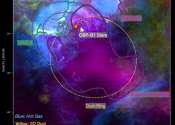Black hole blows big bubble
Combining observations made with ESO's Very Large Telescope and NASA's Chandra X-ray telescope, astronomers have uncovered the most powerful pair of jets ever seen from a stellar black hole. This object, also known as a microquasar, ...









